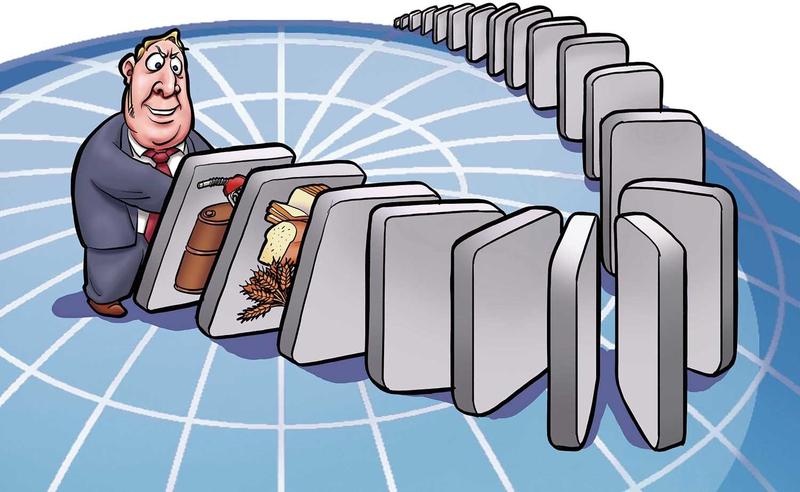 (JIN DING / CHINA DAILY)
(JIN DING / CHINA DAILY)
Sri Lanka's 22 million people are suffering the worst economic crisis in the past seven decades due to an array of serious problems, including depleted foreign currency reserves, rising inflation and shortage of daily necessities, which have sparked months-long protests across the country.
Sri Lankan President Gotabaya Rajapaksa and Prime Minister Ranil Wickremesinghe both agreed to resign after hundreds of thousands of angry protesters stormed their official residences in Colombo on July 9. But Rajapaksa left the country on Wednesday.
Multiple internal and external factors are responsible for Sri Lanka's woes, yet the crisis highlights the economic risks, difficulties and problems a vulnerable country is likely to face in today's fast-changing global landscape. In particular, the crisis can be attributed to the country's fragile economic structure, the government's flawed policies and its inability to deal with challenges, as well as adverse external factors.
Although the crisis has been years in the making, the COVID-19 pandemic dealt a debilitating blow to Sri Lanka. Take tourism for example. The industry contributed more than 10 percent to the country's GDP, but it has been hit hard since the pandemic. About 2 million tourists visited Sri Lanka in 2019, but the number dropped to about 200,000 in 2021. And while the country earned $3.6 billion in tourism revenue in 2019, the pandemic slashed it to less than a seventh in 2021.
Also, overseas Sri Lankans' remittances, a major source of foreign exchange for the country, dropped to a 10-year low to $5.49 billion in 2021-and 22.7 percent less than 2020.
Worse, the ongoing Russia-Ukraine conflict has had a huge impact on Sri Lanka since both countries are key buyers of Sri Lankan tea, its prime cash crop, and important sources of tourists. The conflict has also pushed up food and oil prices in Sri Lanka because the country imports about 45 percent of its wheat and more than half of its soybean from the two countries. Compounding these factors is the shortage of foreign exchange reserves, which has limited imports.
Besides, the industrial structure in Sri Lanka is not strong enough to withstand extreme external pressure, as the service sector accounted for 59.67 percent of GDP in 2020, while the industrial and agricultural sectors accounted for only 26.25 and 8.36 percent. So after the pandemic dealt a serious blow to the tourism sector and the export of cash crops suddenly declined due the Russia-Ukraine conflict, the country's foreign exchange reserves started declining rapidly.
Adding to Sri Lanka's woes was the government debt. After the end of the civil war in 2009, Sri Lanka used debt-backed infrastructure projects to fuel economic growth, but the budget deficit accumulated over the years to become a heavy burden on the economy.
A major reason behind the debt crisis is the government's radical fiscal policy. In 2006, Sri Lanka had an external debt of $11.3 billion, but the figure increased to $43.9 billion in 2015. In April, when it had more than $51 billion in foreign debt, the government announced it cannot repay its international debt due to a balance-of-payment crisis.
Moreover, in 2019, the Rajapaksa administration announced the largest tax cuts in the country's history, slashing value added tax from 15 percent to 8 percent, among other tax concessions, in the hope of reviving the fragile economy. Yet the move, instead of reviving the economy, resulted in the loss of more than $1.4 billion in tax revenue, prompting rating agencies to downgrade Sri Lanka's credit ratings, which prevented it from borrowing any more money from overseas sources to stabilize the economy.
Another controversial policy that fueled the economic crisis was the government's decision in April 2021 to ban chemical fertilizers and enforce a full transition to organic farming. The policy, criticized for being unrealistic and ill-timed, together with the impacts of natural disasters such as heavy monsoons and the pandemic, led to a 20 percent drop in rice production, forcing the government to import $450 million worth of rice and drove up the prices of the staple and other commodities.
Yet while Sri Lanka is struggling to deal with the unprecedented crisis, some Western media outlets are blaming China's "debt trap" for the country's woes. But the truth is that Sri Lanka's debt to China represents only 10 percent of its total external debt. This "debt trap "myth has been fabricated by some unscrupulous Western politicians with the aim of looting a burning house by blaming others for the fire.
China and Sri Lanka have been working closely to promote the Belt and Road Initiative, and as a friend in need, China has promised to supply 10,000 tons of rice to Sri Lanka which can feed 1.1 million students in 7,900 schools for up to half a year. In fact, Sri Lanka received 1,000 tons of rice and some medical supplies on June 8.
China sincerely hopes Sri Lanka will overcome the difficulties and restore stability soon, and will do what it can to help Sri Lanka to get through the crisis.
The author is an associate professor at the National Institute of International Strategy, Chinese Academy of Social Sciences.
The views don't necessarily reflect those of China Daily.


